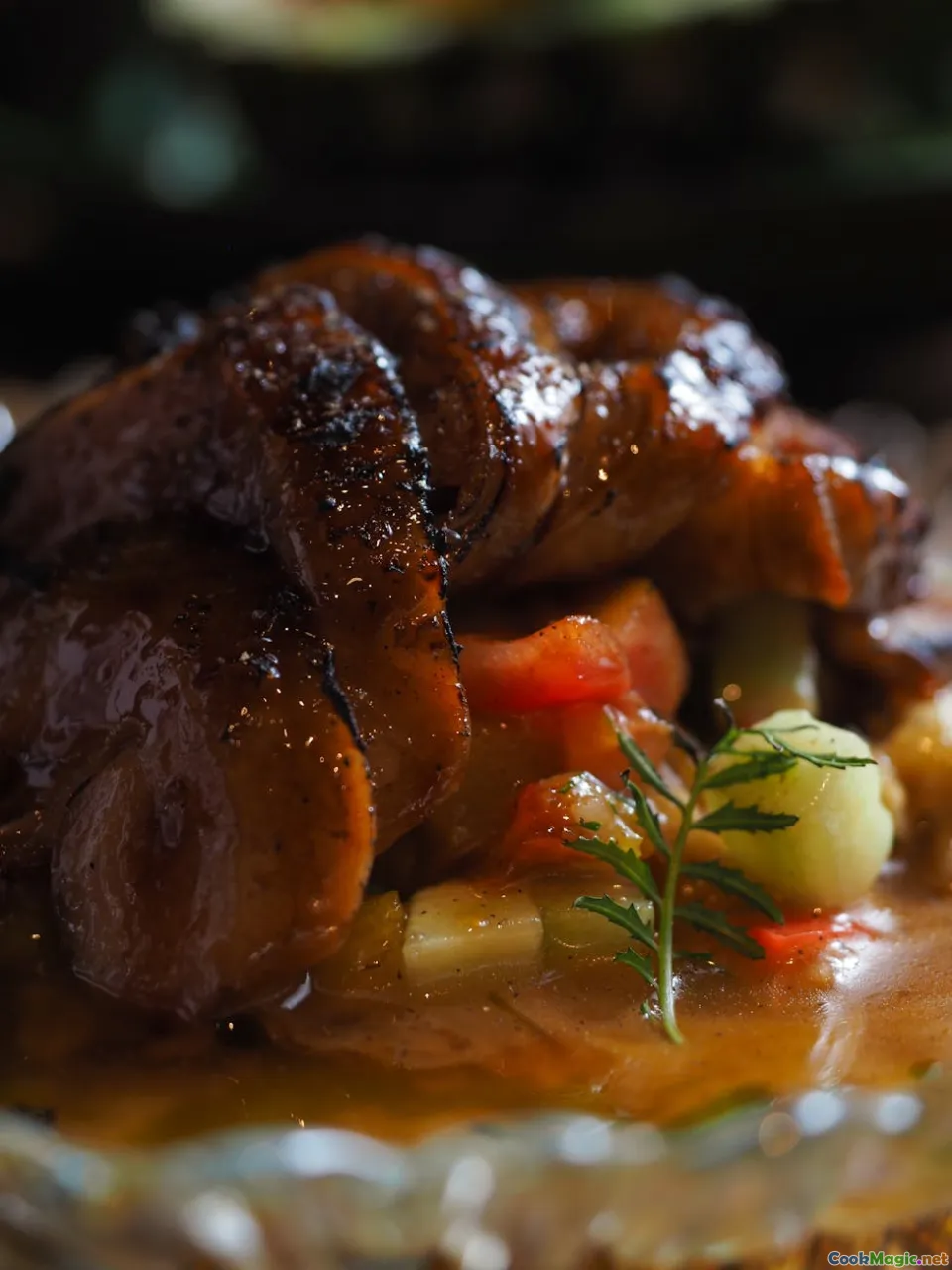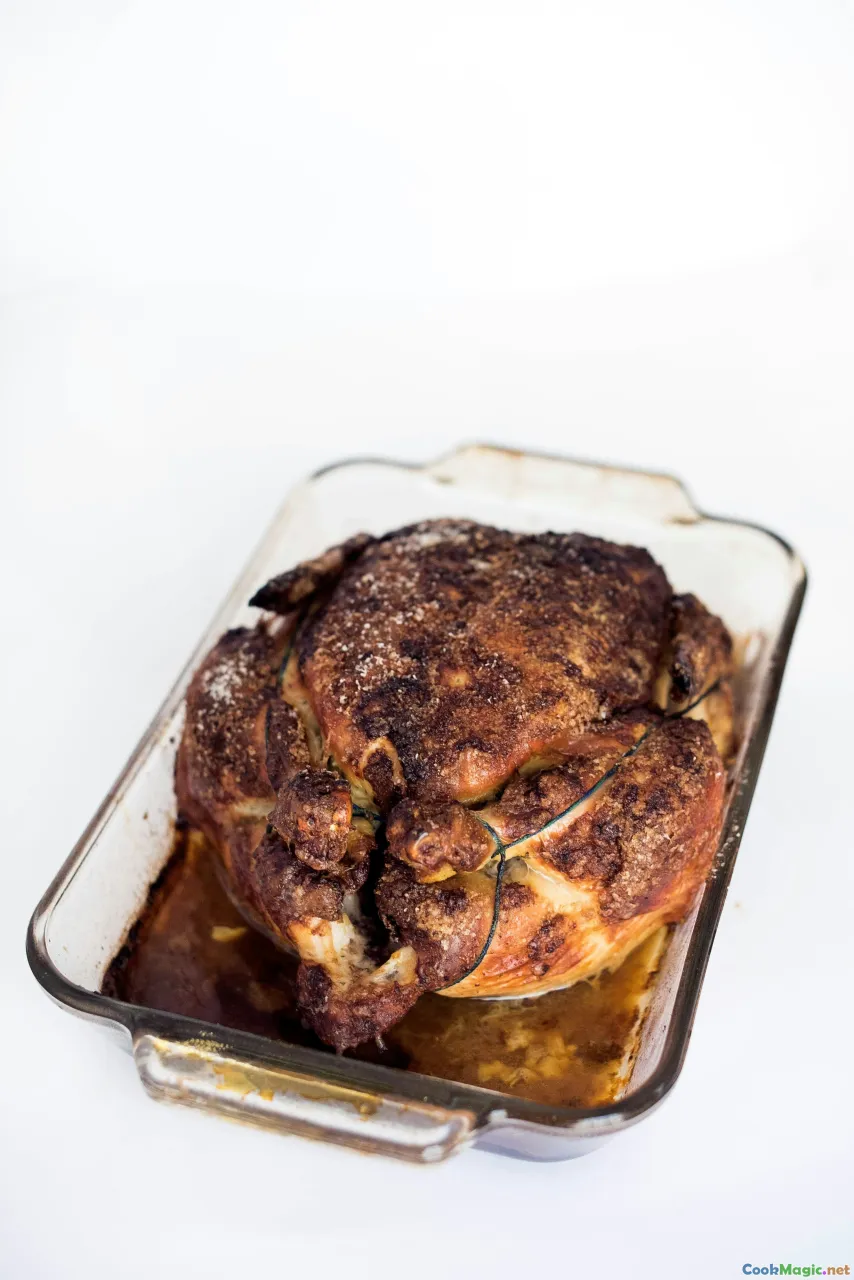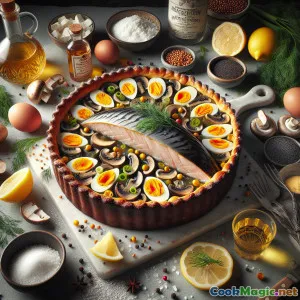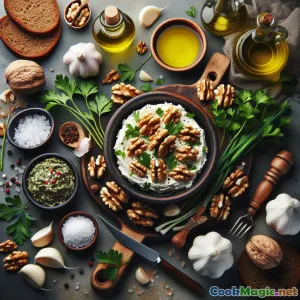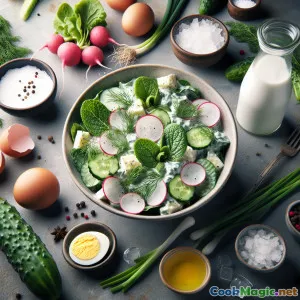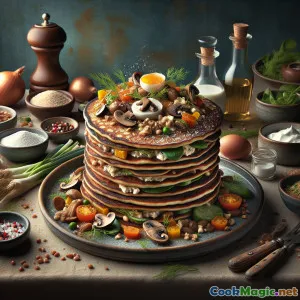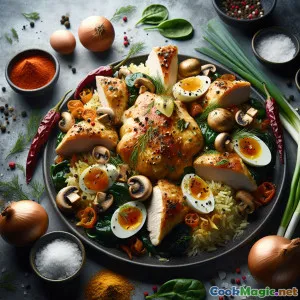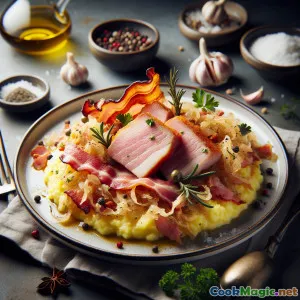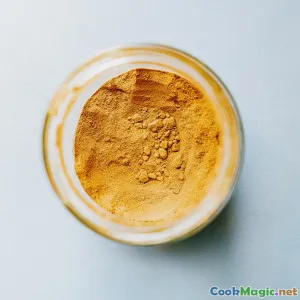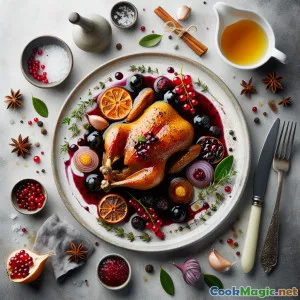
بطة كرملين مع صلصة الكشمش الأسود
(Kremlin Duck with Blackcurrant Glaze)
(0 المراجعات)المكونات
-
2.2 kilograms بطة كاملة
(Prefer a dry-aged duck for crispier skin; pat very dry)
-
2 tsp ملح كوشير
(Adjust to taste; coarse salt helps draw out moisture)
-
1 tsp فلفل أسود مطحون طازجًا
(Cracked pepper adds texture and aroma)
-
1 tbsp زيت محايد
(High smoke point oil like sunflower or grapeseed)
-
2 pieces شلوتات مقطّعة إلى نصفين
(Can substitute with a small red onion)
-
4 cloves فصوص ثوم مقشرة
(Smash to release oils; do not mince)
-
6 sprigs زعتر طازج
(Adds resinous depth to the roasting aromatics)
-
2 leaves ورقة الغار
(Dried bay preferred for a rounder flavor)
-
150 ml نبيذ أحمر جاف
(A medium-bodied wine; Merlot or Saperavi works well)
-
200 ml مرق الدجاج
(Unsalted or low-sodium to control seasoning)
-
180 grams مربى الكشمش الأسود أو الكونسيرف
(Choose a tart, high-fruit conserve for best balance)
-
120 grams عنب الثعلب الأسود الطازج
(Adds bright acidity and texture to the glaze)
-
2 tbsp خل النبيذ الأحمر
(Balances sweetness; taste and adjust)
-
1 tbsp عسل
(Optional for extra sheen and mild sweetness)
-
1 tsp قشر البرتقال المبشور ناعماً
(Citrus lifts the berry notes)
-
2 pods اليانسون النجمي
(Whisper of spice; omit if you prefer classic flavor)
-
30 grams زبدة غير مملحة، باردة
(For glazing and mounting the sauce)
-
1 tsp نشا الذرة
(Mix 1:1 with cold water for slurry to thicken sauce)
-
1 tsp ماء بارد (للخليط المصنوع من نشا الذرة)
(Equal part water to cornstarch)
-
6 pieces شرائط قشر البرتقال
(For garnish; peel with a channel knife)
(Prefer a dry-aged duck for crispier skin; pat very dry)
(Adjust to taste; coarse salt helps draw out moisture)
(Cracked pepper adds texture and aroma)
(High smoke point oil like sunflower or grapeseed)
(Can substitute with a small red onion)
(Smash to release oils; do not mince)
(Adds resinous depth to the roasting aromatics)
(Dried bay preferred for a rounder flavor)
(A medium-bodied wine; Merlot or Saperavi works well)
(Unsalted or low-sodium to control seasoning)
(Choose a tart, high-fruit conserve for best balance)
(Adds bright acidity and texture to the glaze)
(Balances sweetness; taste and adjust)
(Optional for extra sheen and mild sweetness)
(Citrus lifts the berry notes)
(Whisper of spice; omit if you prefer classic flavor)
(For glazing and mounting the sauce)
(Mix 1:1 with cold water for slurry to thicken sauce)
(Equal part water to cornstarch)
(For garnish; peel with a channel knife)
التغذية
- الحصص: 4
- حجم الحصة: 1 carved portion (250g)
- Calories: 780 kcal
- Carbohydrates: 0 g
- Protein: 46 g
- Fat: 54 g
- Fiber: 3 g
- Sugar: 18 g
- Sodium: 820 mg
- Cholesterol: 215 mg
- Calcium: 70 mg
- Iron: 4.7 mg
التعليمات
-
1 - Prep and dry-brine the duck:
Pat the duck dry, remove any giblets, and prick the skin all over with a trussing needle, avoiding the meat. Season generously with salt and pepper, including the cavity. Let rest uncovered in the fridge 30 minutes (or overnight) to dry the skin.
-
2 - Preheat and aromatics:
Heat oven to 230°C (450°F). Stuff cavity with shallot halves, crushed garlic, thyme, and bay leaves. Rub skin lightly with neutral oil.
-
3 - Initial roast for crisp skin:
Place the duck breast-side up on a rack set in a roasting pan. Roast 20 minutes to render surface fat and start crisping the skin. Carefully pour off excess fat into a heatproof bowl.
-
4 - Lower heat and continue roasting:
Reduce oven to 180°C (350°F). Continue roasting 35–40 minutes, pouring off fat once more if needed. Rotate the pan halfway for even browning.
-
5 - Make the blackcurrant glaze:
In a saucepan, combine red wine, stock, blackcurrant jam, fresh blackcurrants (if using), vinegar, honey, orange zest, and star anise. Simmer 8–10 minutes until syrupy. Strain if you prefer smoothness, then whisk in half the cold butter.
-
6 - Lacquer the duck:
Brush the duck with a generous layer of glaze and return to the oven for 8–10 minutes. Repeat once more for a deep, glossy lacquer.
-
7 - Rest the bird:
Transfer the duck to a board and rest 15 minutes. This redistributes juices for moist slices and keeps the skin crisp.
-
8 - Make the pan sauce:
Set the roasting pan over medium heat. Deglaze with a splash of water or wine, scraping fond. Add remaining glaze. If a thicker sauce is desired, whisk in cornstarch slurry and simmer 1–2 minutes. Finish with remaining cold butter.
-
9 - Carve and Serve:
Carve off legs, thighs, and breasts. Slice breasts across the grain. Spoon sauce over and garnish with orange peel strips. Serve immediately.
Pat the duck dry, remove any giblets, and prick the skin all over with a trussing needle, avoiding the meat. Season generously with salt and pepper, including the cavity. Let rest uncovered in the fridge 30 minutes (or overnight) to dry the skin.
Heat oven to 230°C (450°F). Stuff cavity with shallot halves, crushed garlic, thyme, and bay leaves. Rub skin lightly with neutral oil.
Place the duck breast-side up on a rack set in a roasting pan. Roast 20 minutes to render surface fat and start crisping the skin. Carefully pour off excess fat into a heatproof bowl.
Reduce oven to 180°C (350°F). Continue roasting 35–40 minutes, pouring off fat once more if needed. Rotate the pan halfway for even browning.
In a saucepan, combine red wine, stock, blackcurrant jam, fresh blackcurrants (if using), vinegar, honey, orange zest, and star anise. Simmer 8–10 minutes until syrupy. Strain if you prefer smoothness, then whisk in half the cold butter.
Brush the duck with a generous layer of glaze and return to the oven for 8–10 minutes. Repeat once more for a deep, glossy lacquer.
Transfer the duck to a board and rest 15 minutes. This redistributes juices for moist slices and keeps the skin crisp.
Set the roasting pan over medium heat. Deglaze with a splash of water or wine, scraping fond. Add remaining glaze. If a thicker sauce is desired, whisk in cornstarch slurry and simmer 1–2 minutes. Finish with remaining cold butter.
Carve off legs, thighs, and breasts. Slice breasts across the grain. Spoon sauce over and garnish with orange peel strips. Serve immediately.
المزيد عن : بطة كرملين مع صلصة الكشمش الأسود
Overview
Kremlin Duck with Blackcurrant Glaze is a celebratory dish that marries the rich, succulence of roasted duck with the bright, tart personality of blackcurrants—one of Northern and Eastern Europe’s most beloved berries. The result is a lacquered bird with crackling skin and jewel-toned sauce, perfect for a winter banquet or any feast that calls for a touch of imperial drama. The name nods to Moscow’s historic heart, evoking images of gilded halls, snow-dusted nights, and tables set with polished samovars and cut crystal.
This recipe focuses on three pillars: properly dried skin for maximum crispness, a balanced glaze that leans into blackcurrant’s natural acidity, and a roast schedule that respects duck’s unique fat rendering. A brief dry-brine draws surface moisture out of the skin, ensuring it blisters into a shattering crust. Meanwhile, a reduction of red wine, stock, and blackcurrant jam—with optional fresh berries—delivers a glossy finish with nuanced sweetness, sharpened by vinegar and brightened with orange zest. A final butter enrichment makes the sauce silk-smooth without becoming cloying.
Why it Works
- Blackcurrant’s tartness is a natural foil for duck’s richness, similar to classic French duck à l’orange or bigarade. The berry’s tannic depth holds its own against the fat.
- A two-stage roast—hot start, lower finish—begins crisping the skin early while allowing time to render fat without overcooking the meat.
- Periodic fat-pouring prevents sogginess. Save that liquid gold for potatoes or kasha.
- A lacquered finish (two brushings) builds shine and flavor layers without burning sugars.
Ingredient Notes
- Duck: A 2–2.5 kg bird yields generous servings for four. If you can find dry-aged duck, even better; its skin dries more readily.
- Blackcurrants: Fresh berries add texture and pop, but a high-fruit conserve alone still produces a superb glaze. Avoid overly sweet jams—balance is key.
- Wine: A medium-bodied dry red adds backbone without overwhelming. Traditionalists might enjoy a Georgian Saperavi for regional flair.
- Aromatics: Thyme, bay, and alliums echo the herb gardens found across Russian estates. Star anise is optional, adding quiet perfume rather than dominant spice.
Technique Tips
- Scoring vs. pricking: For whole duck, pricking with a needle is safer; it minimizes cutting into meat while still venting fat. Focus on thick, fatty areas like the breast.
- Drying time: Even a short 30-minute air-dry in the fridge helps. Overnight drying yields spectacular skin.
- Glaze management: Reduce until it clings to the back of a spoon. If it tightens too much, splash in stock or water. If it’s too sweet, correct with vinegar or a squeeze of lemon.
- Resting: Resting is non-negotiable. It keeps the meat juicy and makes carving easier.
- Sauce texture: For an elegant finish, strain the glaze. For rustic charm, keep the berries whole.
Serving Suggestions
- Classic: Serve with roasted potatoes tossed in reserved duck fat and dill.
- Rustic: Spoon over buckwheat kasha with fried mushrooms—an earthy counterpoint to the glaze.
- Fresh: Add a crisp salad of shaved fennel and apple to cut richness.
- Festive: Garnish with candied orange peel or a few fresh blackcurrants where available.
Make-Ahead and Variations
- Make-ahead glaze: Prepare the glaze up to 3 days in advance and rewarm gently. Finish with butter at the last moment.
- Spiced route: Add a strip of cinnamon or allspice to the reduction for a warmer winter profile.
- Citrus pivot: Swap orange zest for lemon if you prefer extra brightness.
- Game birds: The glaze is excellent on goose or pheasant; adjust times accordingly.
Cultural Notes
Blackcurrants (smorodina) have a storied place in Russian and Eastern European kitchens—preserved in jams and compotes, infused into kvass and liqueurs, and prized for their bold, inky flavor. Pairing them with duck echoes age-old traditions of balancing rich roasts with sharp-fruited sauces, a culinary conversation shared by neighbors across borders. This dish, while modern in technique, pays homage to banquet tables where contrasts—fat and acid, dark and bright—were not just taste decisions but symbolic of warmth in deep winters.
Chef’s Notes
- Temperature realities: Every oven is different. Trust visual cues—bronzed skin and rendered fat—over the clock. If skin darkens too fast, tent lightly with foil.
- Don’t waste the fat: Strained duck fat is liquid velvet. Roast potatoes, sauté cabbage, or fry blini for breakfast.
- Target doneness: For juicier breast meat, you can remove breasts earlier (at about 60–63°C/140–145°F), then return legs to finish until tender.
Wine and Pairing
Pour a medium-bodied red with bright acidity: Pinot Noir, Saperavi, or a restrained Syrah. For white, an oaked Chardonnay with sufficient cut will also sing. Non-alcoholic options include tart black tea with a slice of lemon or a blackcurrant spritz.
Luxurious yet grounded, Kremlin Duck with Blackcurrant Glaze is the kind of centerpiece that invites stories and seconds. It’s winter sunlight in sauce form—deep, ruby, and full of promise.

